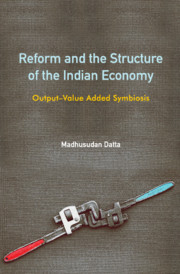Book contents
- Frontmatter
- Dedication
- Contents
- Tables
- Figures and Box
- Preface
- 1 Introduction: The Take-off
- 2 Growth and Structural Change since 1978–79: Issues in Measurement
- 3 Sectoral Shares in Indian GDP: How to Regard It?
- 4 Sectoral Growth: GVA–Output Dichotomy
- 5 Manufacturing Sector in the Indian Economy: Paradox of Growth and Stagnation
- 6 Growth and Sectoral GVA Adjustments
- 7 Demand for Intermediate Services
- 8 Linkages and Key Sectors in the Indian Economy
- 9 Conclusion: A Perspective of Indian Economic Growth
- References
- Index
5 - Manufacturing Sector in the Indian Economy: Paradox of Growth and Stagnation
Published online by Cambridge University Press: 17 March 2020
- Frontmatter
- Dedication
- Contents
- Tables
- Figures and Box
- Preface
- 1 Introduction: The Take-off
- 2 Growth and Structural Change since 1978–79: Issues in Measurement
- 3 Sectoral Shares in Indian GDP: How to Regard It?
- 4 Sectoral Growth: GVA–Output Dichotomy
- 5 Manufacturing Sector in the Indian Economy: Paradox of Growth and Stagnation
- 6 Growth and Sectoral GVA Adjustments
- 7 Demand for Intermediate Services
- 8 Linkages and Key Sectors in the Indian Economy
- 9 Conclusion: A Perspective of Indian Economic Growth
- References
- Index
Summary
… to do development theory, one must have the courage to be silly, writing down models that are implausible in the details in order to arrive at convincing higherlevel insights.
—Krugman (1998: 15)Introduction
Stories abound about how India treated its private enterprise before the comprehensive reform was launched in 1991. Entrepreneurs, who were pioneers in their own fields, used to get the feeling that they were being treated as greedy pursuers of monetary gains; they had to run from pillar to post wasting time, energy and money, to get sanctions for crucial business matters. The public sector emerged to provide a good foundation of basic and heavy industries, but in this process, the animal spirit of the private entrepreneurs was caged in a network of license and permit legislations. Inadequacies of the public sector became increasingly evident as time wore on and presumably the first real step to break out of the public sector mindset was allowing the entry of Suzuki Motors in India in 1983, in an eloquent declaration of intent to let the caged animal spirits fly.
Development under successive Five Year Plans over the past decades was, however, quite significant though below potential. By the turn of the 1970s, the industrial sector achieved some depth by developing the basic and heavy industries, as is evident from their being comfortably placed by international comparison of sectoral weights (Chapter 3). The Green Revolution of the 1970s reduced the extent of agriculture's dependence on weather and resolved the problem of recurrent food crises. The service sector was not very dominant at this stage; rather, it was an underperformer by the K-CT norm, as already discussed. During the 1980s, the GDP growth shifted to a higher trajectory and the private sector started showing animation with signs of change in government attitude. The three-year averages of gross fixed capital formation (GFCF) as a percentage of GDP were similar for the public and private sectors during 1977–80 (a little below 9 per cent); but just before the reform, during the three years to 1991, the private sector investment surpassed that of the public sector by almost two percentage points (12.3 versus 10.5).
- Type
- Chapter
- Information
- Reform and the Structure of the Indian EconomyOutput-Value Added Symbiosis, pp. 70 - 100Publisher: Cambridge University PressPrint publication year: 2020



